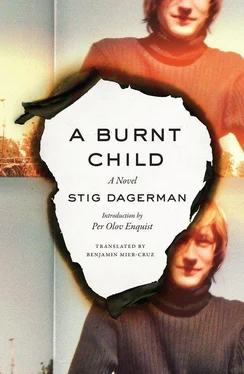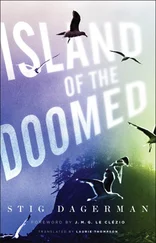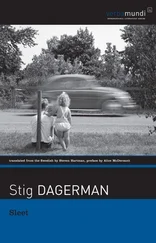Look, he whispers.
And the son looks. He sees the cars pulling up around the corner in a long procession. Five black cars in bluish snow. Five black cars relentlessly gliding up to the entrance and gently stopping with snow on their roofs.
Three would have probably been enough, the aunt with glasses whispers so that no one will hear, yet so that almost everyone does.
And three certainly would have been enough, but there had to be at least five black cars for it to be eye-catching. The father adores things that attract attention, and he adores things that are beautiful. So he ordered five.
They have to walk down four flights of stairs to reach the cars. They descend very slowly as if for the last time. The father goes first, then the son, and then the thirteen others. Through the staircase windows they can see the snow falling more and more heavily and draping the hangers on the carpet-beating rack in gray clouds. And if it doesn’t clear up, the cars won’t be visible at all. Now all fifteen of them are silent, no sixteen, for the son’s fiancée meets them on the third flight. She is thin and pale and had trouble getting time off from the clothing shop in Norr Mälarstrand. She has snow on the front of her black coat, snow on her black gloves, and snow on the veil of her hat, so that only her eyes are visible. And she was probably crying. But who knows why?
The black procession glides silently down the stairs. Neighbors open their doors and look on in grave silence. It is a beautiful performance with fine roles. A child begins to cry and cleaves desperately to the wall as though it were looking at death itself. Once they have passed, all the doors close in compassionate silence. The son goes first, followed by the son’s fiancée, then the father, and finally the thirteen others. The stone steps are hard, and the clanging of their heels and the rustling of their black clothes are dreadful. Dreadful is the snow outside as it falls silently and heavily, burying all the living and the dead. Dreadful, too, is the length of the steps. They walk and walk but never reach the bottom. The son reaches for the fiancée’s hand but only finds her cold, wet glove. He squeezes it hard, harder, but only to feel how cold she is. He peers down the stairs and continues walking on and on. The grooves are deep in the steps of sorrow and full of salt and sand.
Most dreadful is the sight awaiting him at the final step. Beautiful yet dreadful. Without realizing it, he has let go of the fiancée’s hand and walks alone through the dark entrance to the street door. But just before he opens the door and meets the patient cars glowing dimly like shadows through the snow and glass, it strikes him how still and gloomy it is behind him. He slowly turns around on the doormat and catches a glimpse of something he will never forget, because it is so beautiful and so dreadful. All fifteen of them in black have stopped halfway down the steps. They are obscuring the window with their bodies, making it very dark. The women’s faces glisten as hard as bone through their thick veils. Everything else is gloomy: the stairs, the walls, and the somber clothes. Only their faces are white, as well as a single gloveless hand pressed against a coat. For a moment, they stand completely still, as if waiting for an invisible photographer. Then they drift slowly down to him like one giant shadow. The steps of sorrow have ended.
Snow is falling outside. An unseen streetcar jingles as it rolls by. The streetlights glow dimly over some roadwork. They climb into the cars with snow on their clothes. With sixteen people to five spacious cars, they are forced to sit far apart from each other and freeze. Just as they are about to leave, the snow begins to subside enough for people to see them depart. They pick up the pastor at the parsonage. He is waiting for them, bareheaded, in the vestibule. He climbs into the car of the immediate family and sits in the front seat, next to the chauffeur. He shakes their hands through the window, drawing out his solemn gaze at each one of them. His eyes are clouded with tears from the biting wind, but for a brief moment they almost think he is crying.
On the way he asks them about the deceased. What her life was like, what she died of, and how she died. The father answers for the four of them: for himself, for the son, for the son’s fiancée, and for his pretty sister. He doesn’t like priests. He just thinks it’s nice to have one. So he answers sullenly that she lived like poor people do. When she could, she went off to clean, and when she could no longer do that, she stayed home, lying around mostly. Had a bad temper. Otherwise, she was nice, nice for the most part. At least she meant well. She was bloated in the end and had trouble with stairs.
The son is sitting by the window, gazing out. It’s clearing up outside, and the sky over Södermalm is as clear as ice. The street they are on is cold and rough, and the wind’s fierce broom sweeps over the sidewalks, taking a hat with it, a new black hat. There is a pale man in a butcher shop with a saw in his hand . . . she had trouble with stairs . . . yet they still let her go. They drive over the bridge. The canal is frozen. Thin ski tracks zigzag across it. At the dock, a boat is paralyzed askew in the frozen water.
In which hospital did Mrs. Lundin pass away? the pastor asks.
They are all taken aback by this and look down at the floor of the car. For a long time, the father explains what she died of, for a really long time, almost until they can see the gates of the cemetery. But how she died is nobody’s business. The pale fiancée turns around and looks at the son. But he is looking out the rear window, watching how the other cars are rolling up, one after the other, along the long white curve. It’s really quite beautiful with so many lined up, and someone stops to look.
She died at home? the pastor asks.
Yes, says the beautiful sister, exactly. She died at home.
Then they arrive.
They walk down the long path to the chapel. The wind slashes through veils and whips tears from their eyes. The pastor and the father go first. Then the son and the fiancée. Then the aunts, hand in hand. Then the father’s relatives from the country. Then the four fake friends. Then the two female neighbors. Lastly, the sick neighbor, who is only thinking about his illness.
They do not take up a lot of space in the chapel. The father plops down on the first pew with his black hat in his hand. He looks over his shoulder to see if anyone else is coming, but there is no one in sight. Actually, as soon as everyone sits down, two women appear with a flag. Before the deceased became ugly and bloated, she had once belonged to a women’s club. They have all but forgotten, but the club has not forgotten. And as the woman carrying the flag proceeds down the aisle with the banner valiantly raised, the widower, too, remembers it painfully well. He didn’t mean any harm by it, but one evening he snapped at her for dashing off to the meetings, and she never went again. Regardless, the banner is beautiful with its black mourning veil, and the one carrying it isn’t so bad herself. Her face was already red because of the wind, but now it turns crimson on account of the eighteen sets of eyes on her. Some of the relatives from the country in the second pew are somewhat upset by the red banner, but as someone whispers, At least it has a crepe, a mourning crepe, that is.
The yellow casket is in the middle of the room, and although they have tried to avoid looking at it, they are ultimately forced to acknowledge it’s there. It’s there on its bier and looks magnificent with its eight wreathes. And if they tilt their heads, they can read what it says on the ribbons.
A final farewell from the Carlsson family, a woman reads quietly into her husband’s ear. Then she suddenly begins to sob. It is their wreath. And it is beautiful.
Читать дальше












